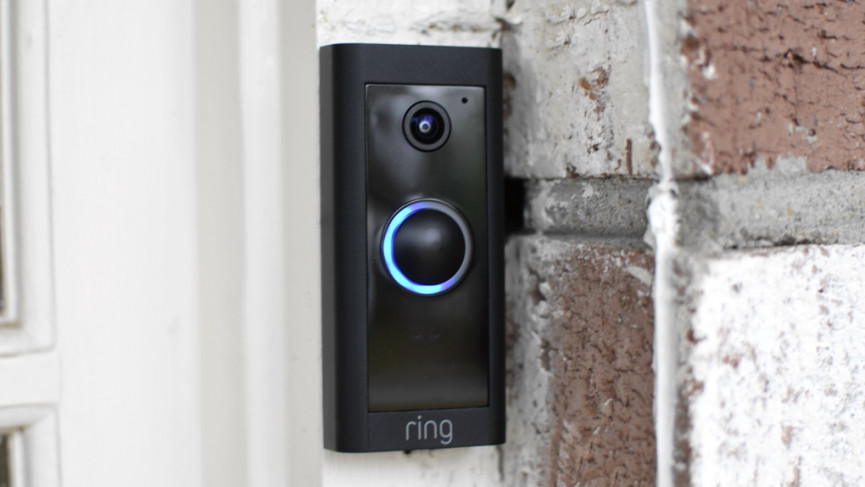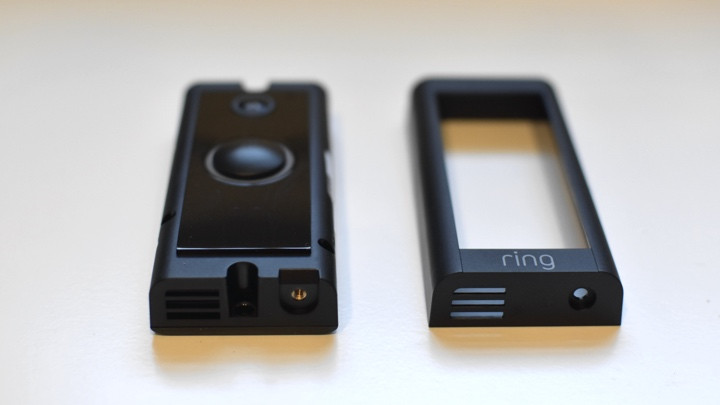Smaller, cheaper, faster but you pay for it with video quality
Ring Wired fills a large hole in Ring's line (yes, surprisingly there was one!). It's a budget option with the speed and reliability benefits of a wired doorbell. If you have wires and want a decent doorbell for under $100, this is the best option right now. If you don't need top-of-the-line video quality, this is the buzzer for you. If you want better footage (as well as some other fancy features) pick up a Ring Pro 2, which is the best video doorbell you can buy.
Pros
- Inexpensive
- Pre-roll video
- Fast
- Works with Alexa
- Nice compact design
Cons
- Won't work with your chime
- Poor video quality
- Can't see your porch
- No HomeKit or Google Home
- 2.4GhZ only
Today’s video doorbells can answer the door for you, tell the carpet salesman to take a hike, recognize a package and “protect” it for you, and even announce exactly who is at the door.
But some of us just want a smart doorbell that simply shows us who’s at the door on our phone, lets us talk to them, and doesn’t cost more than a new pair of jeans. Enter, the Ring Video Doorbell Wired. At just £49 this is Ring’s cheapest, entry-level doorbell.
New model: Ring Video Doorbell 4 review
Similar in specs to Ring’s 2nd-gen video doorbell, the least-expensive option if you are a wire-free doorbell home, the Ring Wired is a basic, smart buzzer with the features you need but none of the bells and whistles (literally – it won’t actually ring your indoor bell).
Top picks: The very best smart video camera doorbells
There’s no package detection, no Alexa talking back and definitely no facial recognition, but what’s notable here is a truly wired doorbell from Ring for the budget-conscious smart home.
All Ring’s battery-powered doorbells are advertised as “wired” but in reality the wiring is just a backup, trickle charging your battery so you don’t have to recharge it constantly. They’re still battery-powered. And battery-powered doorbells are slow.
Wired doorbells on the other hand are much snappier at delivering you alerts and capturing the action at your door before the person is halfway down your driveway. This is because they don’t have to wait as long to “wake-up” as their battery-powered brethren.
Need more help? Read this: Smart Home Wiring 101
If you have doorbell wiring you should buy a wired doorbell. Previously Ring’s only truly wired option was the Ring Pro 2 for £220. Now, with the Ring Wired, Ring finally has an affordable and reliable smart doorbell.
So, how does the Ring Wired stack-up against it’s wiry competition – the Arlo Video Doorbell, Nest Hello, Eufy Doorbell 2K and the even lower-priced Wyze Video doorbell?
We’ve been living with the Ring Wired Video Doorbell for a month now, read on for our full review.

Ring Wired is the smallest Ring. Ring Pro 2 is on the left and Ring Wired on the right.
But first, which Ring is which?
Ring has been churning out doorbells like they’re going out of style, so it’s easy to get confused as to which one’s which, which does what differently, and – most importantly – which one’s right for you. To help you out, here’s a quick run down of the latest lineup with links to our reviews:
- Ring Wired: £49.99
- Ring Video Doorbell (2nd-gen): £89.99
- Ring Video Doorbell Pro (wired): $169.99
- Ring Video Doorbell 3: £139.99
- Ring Video Doorbell 3 Plus: £159.99
- Ring Video Doorbell 4 (review coming soon): $199.99
- Ring Video Doorbell Pro 2 (wired): £1
- Ring Video Doorbell Elite (wired): $349.99
- Ring Peephole / Door View Cam: £119.99
All the doorbells share the same 1080p HD video quality for live streaming (with the exception of the Pro 2), the same app, and many of the same features, some of which require subscribing to Ring Protect Plan to get. You’ll also need to pay to view and access recorded video on any Ring doorbell.
The main differences come in how they are powered (built-in battery, removable battery or wired), their connectivity (2.4GHz, 5GHz or Ethernet), their design/form factor, and some more advanced detection features on the higher-end models.

Ring Wired Video Doorbell: Design & setup
For the most part, the Ring video doorbell aesthetic is loud proud, you can spot them on front doors from the street – and that’s likely on purpose.
But if you prefer a more subtle look on your front door you’re going to like Ring Wired.
Verdict: Blink Video Doorbell review
Taking its styling cues from the higher-end Ring Pro, Ring Wired is small, discreet and comes in a nice matte black (interchangeable faceplates in grey, dark grey, blue, while and gold are on offer for $15 each).

When we say small we mean tiny. This is the smallest doorbells we’ve tested. It’s smaller than a chocolate bar and will easily fit on most door frames.
Install isn’t as easy as with most Ring products, because in order to keep the low price you don’t get any handy wedges or backplates included. Meaning you have to screw it directly onto your door frame.
Ding dong: Ezviz DB2 review
This makes the process a little trickier, although Ring makes it as easy as possible with clear, step-by-step instructions. They definitely have this process nailed down.

The issue we had is that in our setup we need a bit of room to tuck away the wires – and without a wedge there’s just nowhere for them to go, so the doorbell couldn’t lay flat on the frame (as you can see in this picture).
You can purchase a wedge for an extra $10, and you’ll want to do that if you need an angle to see your entryway properly.
Part of the install includes popping an included jumper wire on to bypass your existing doorbell chime’s wiring. This has to be installed if you have an electronic or mechanical chime, as the Ring Wired will not work with existing chimes. You’ll have to hook it up to an Echo speaker or a Ring Chime if you want to hear it ring in your home.
This is a shame and one of the biggest negatives of the product. We assume it’s another cost-cutting method. The Ring Pro line includes a Pro Power Kit to attach to your chime, which not only makes your doorbell go ding-dong but helps deliver more power to the doorbell, enabling more of the pro features of those models.

Ring Wired Video Doorbell: Features
While this is an entry-level device, all the standard Ring smart doorbell features are present and correct. You also get the full power of Ring’s impressive app and all the related integrations with other Ring devices, plus full-on compatibility with Amazon’s Alexa (Ring is owned by Amazon).
This means you can have a live feed from your doorbell pull up on a screen-enabled Echo the second someone presses the bell, and have your Echo speakers announce you have a visitor. The buzzer can also be used in Alexa Routines.
On the hardware front there’s 1080p HD video with night vision and two-way audio on board, live view from the camera in the app, motion and ring alerts, adjustable motion sensitivity and customizable motion/privacy zones to help cut down on nuisance alerts.
Plus, if you pay for Ring Protect (£2.50 a month for one device) you add motion-activated recording with a 60-day video history, People Only mode to get alerts only when there’s someone at your door, and rich notifications that show you a snapshot of the action so you don’t always have to open the app.

Also included is a handy “advanced pre-roll” feature and “snapshot capture.” The latter takes a picture every 30 seconds, 1 minute or 3 minutes to give you a scrollable timeline of what’s been going on in your front yard. Ring’s version of 24/7 recording, we suppose.
Advanced pre-roll adds extra video to the start of any motion-activated recording so you can see what happened before an event was triggered.
This is a killer feature previously only available on the Pro and Elite doorbells (the Ring 3 Plus and the new Ring 4 have a different type of pre-roll as they’re battery-powered). It completely does away with the back-of-the-head problem most video doorbells suffer from.
Consistently in our testing the Ring Wired got all the action – including the 20 seconds or so it takes the delivery driver to walk through our front yard and up to the door. You can also set the doorbell to record up to 120 seconds per event, making sure you don’t miss a moment.

But, Ring Wired is still the bottom of the line, and that’s noticeable in one key area – video.
Video quality is poor, especially compared to the Pro 2, but also when compared to competitors like the Eufy Video Doorbell (which offers 2k video) and the Arlo with its 1536 x 1536 resolution and HDR imaging.
Those buzzers are more costly however, and video quality is what you lose when you go for the budget option.

As we’ve mentioned, you also lose the option of your existing chime, which means you need to pick up one of Ring’s plug-in Chimes for £29.99, or bundled with the doorbell for $75. (The Pro version for £49.99 helps out with connectivity if your doorbell is a ways from your router).
You can also use an Echo speaker in your house as a chime, having one, all or some announce “There’s someone at the front door” when someone presses the bell. It can also alert you that “There’s motion at the front door,” if you choose.
Ring Wired Video Doorbell: Performance
About that video. It’s just blah. Dull colors, shadowy faces and pixelation around movement.
On the plus side, it’s pretty sharp and the advanced motion detection with the pre-roll feature mean you get to see the whole picture, so to speak.
As you’ll see in the above video, the Ring Wired captured the UPS driver arriving, walking up to the door and then driving away. You can also see quite clearly the people walking their dog a good 200 yards from the front door.
But when it comes to discerning faces at the door it’s just too dark and shadowy.

While we quite like Ring’s wide field of view – which comes from the company’s long held attachment to a traditional 16:9 aspect ratio, as we have a wide front yard, But as with all other Ring doorbells (apart from the Pro 2), it means you can’t see the part of our porch where the packages are often left.
Also, the lack of a wedge mount meant we lost a lot of the benefit of that wide view, cutting out the entire left side of the 160-degree view.
Night vision was better than we expected, although again, no wedge mount meant we got glare off the wall from the infra-red LEDs, cutting down the view.

Two-way audio worked very well in testing. Clear with very little lag time, we could hear and talk to visitors with ease.
We were also really impressed with the speed of the Ring Wired. Alerts came in almost instantly on our iPhone and tapping on a notification to pull up a live feed took just 2 to 3 seconds, compared to 8 to 10 on Ring’s battery-powered buzzers.
These two benefits come from that hardwired connection. A wired video doorbell is just a better experience all around and that’s true with Ring Wired, too. It’s snappier, more reliable and easier to use than any of its battery-powered buddies.






